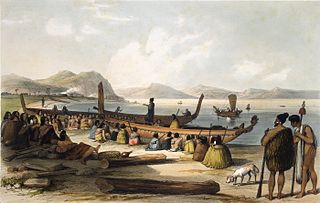
Gisborne is a city in northeastern New Zealand and the largest settlement in the Gisborne District. It has a population of 38,200. Gisborne District Council has its headquarters in the central city.

Waka are Māori watercraft, usually canoes ranging in size from small, unornamented canoes used for fishing and river travel to large, decorated war canoes up to 40 metres (130 ft) long.

Maketu is a small town on the Western Bay of Plenty coast in New Zealand.

Kupe was a legendary Polynesian explorer who was the first person to discover New Zealand, according to Māori oral history. It is likely that Kupe existed historically, but this is difficult to confirm. He is generally held to have been born to a father from Rarotonga and a mother from Raiatea, and probably spoke a Māori proto-language similar to Cook Islands Māori or Tahitian. His voyage to New Zealand ensured that the land was known to the Polynesians, and he would therefore be responsible for the genesis of the Māori people.
Arawa was one of the great ocean-going, voyaging canoes in Māori traditions that was used in the migrations that settled New Zealand.

Various Māori traditions recount how their ancestors set out from their homeland in waka hourua, large twin-hulled ocean-going canoes (waka). Some of these traditions name a homeland called Hawaiki.

In Māori tradition, Aotea is one of the canoes in which Māori migrated to New Zealand; it is particularly associated with the tribes of Taranaki and Whanganui, including Ngāti Ruanui, Ngāruahine, Ngā Rauru and other tribal groups.
Tākitimu was a waka (canoe) with whakapapa throughout the Pacific particularly with Samoa, the Cook Islands, and New Zealand in ancient times. In several Māori traditions, the Tākitimu was one of the great Māori migration ships that brought Polynesian migrants to New Zealand from Hawaiki. The canoe was said to be captained by Tamatea.
Mātaatua was one of the great voyaging canoes by which Polynesians migrated to New Zealand, according to Māori tradition. Māori traditions say that the Mātaatua was initially sent from Hawaiki to bring supplies of kūmara to Māori settlements in New Zealand. The Mātaatua was captained by Toroa, accompanied by his brother, Puhi; his sister, Muriwai; his son, Ruaihona; and daughter, Wairaka.

Māori mythology and Māori traditions are two major categories into which the remote oral history of New Zealand's Māori may be divided. Māori myths concern tales of supernatural events relating to the origins of what was the observable world for the pre-European Māori, often involving gods and demigods. Māori tradition concerns more folkloric legends often involving historical or semi-historical forebears. Both categories merge in whakapapa to explain the overall origin of the Māori and their connections to the world which they lived in.

Tauhara College is a state coeducational secondary school located in Taupō, New Zealand. Serving Years 9 to 13, the school has approximately 600 students.

Ngāti Hau are the Māori iwi (tribes) of the Whanganui River area in New Zealand.
In Māori tradition, Arautauta was one of the great ocean-going, voyaging canoes that was used in the migrations that settled New Zealand. It was piloted by Tarawa and landed near Ōhiwa.
In Māori tradition, Ōtūrereao was one of the great ocean-going, voyaging canoes that was used in the migrations that settled New Zealand. It was piloted by Tairongo or Taikehu and landed at Ōhiwa.
In Māori tradition, Pangatoru was one of the great ocean-going, voyaging canoes that were used in the migrations that settled New Zealand.
In Māori tradition, Riukākara was one of the great ocean-going, voyaging canoes that was used in the migrations that settled New Zealand. In the story, Pāoa piloted the waka to land at Mangōnui.
In Māori tradition, Mānuka was one of the great ocean-going, voyaging canoes that was used in the migrations that settled the South Island of Aotearoa. The canoe is said to have travelled to the Polynesian homeland of Hawaiki to procure kūmara, a type of sweet potato. Although the Mānuka returned with kūmara, most accounts state that efforts to germinate and grow the tubers it brought back ended in failure.

Māori are the indigenous Polynesian people of mainland New Zealand. Māori originated with settlers from East Polynesia, who arrived in New Zealand in several waves of canoe voyages between roughly 1320 and 1350. Over several centuries in isolation, these settlers developed their own distinctive culture, whose language, mythology, crafts, and performing arts evolved independently from those of other eastern Polynesian cultures. Some early Māori moved to the Chatham Islands, where their descendants became New Zealand's other indigenous Polynesian ethnic group, the Moriori.

Dame Lisa Marie Carrington is a flatwater canoeist and New Zealand's most successful Olympian, having won a total of five gold medals and one bronze medal. She won three consecutive gold medals in the Women's K‑1 200 metres at the 2012 Summer Olympics, 2016 Summer Olympics and 2020 Summer Olympics, as well as gold in the same event at the 2011 Canoe Sprint World Championships. At the 2020 Summer Olympics she also won a gold medal in the K‑2 500 metres, with crewmate Caitlin Regal, and as an individual in the K‑1 500 metres.










